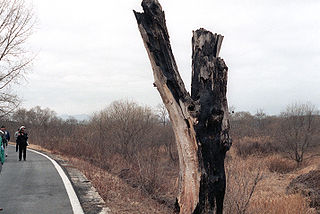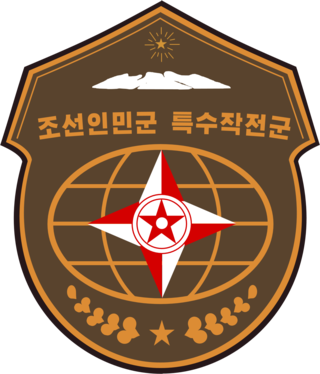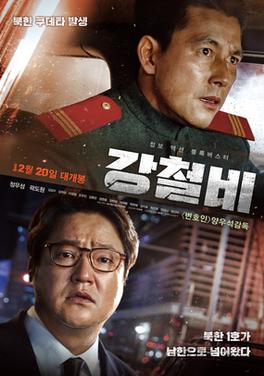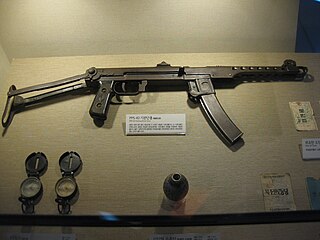
Gangneung is a municipal city in Gangwon State, on the east coast of South Korea. It has a population of 213,658. Gangneung is the economic centre of the Yeongdong region of Gangwon State. It has many tourist attractions, such as Jeongdongjin, a very popular area for watching the sunrise, and Gyeongpo Beach. The city hosted all the ice events for the 2018 Winter Olympics and the 2024 Winter Youth Olympics.

The Korean DMZ Conflict, also referred to as the Second Korean War by some, was a series of low-level armed clashes between North Korean forces and the forces of South Korea and the United States, largely occurring between 1966 and 1969 along the Korean Demilitarized Zone (DMZ).

The Russian commando frogmen, informally called "commando frogmen" in civilian media, are a Russian Naval Spetsnaz unit under operational subordination to the Main Intelligence Directorate (GRU). It is the special forces unit of the Russian Naval Infantry and is composed of highly trained and elite marines within the Naval Infantry. By virtue of belonging to the Russian Naval Infantry, frogmen fall under the Coastal Troops of the Russian Navy service arm. The Russian Navy proper does not field any special forces or special operations units. Russian FSB special forces Alpha Group and Vympel also have frogman units in their respective naval components.

The Korean axe murder incident was the killing of two United Nations Command officers, Captain Arthur Bonifas and First Lieutenant Mark Barrett, by North Korean soldiers on August 18, 1976, in the Joint Security Area (JSA) in the Korean Demilitarized Zone (DMZ). The officers, from the United States Army, had been part of a work party cutting down a poplar tree in the JSA.

Choe Deok-geun, also spelled Choi Duck-keun or Choi Duk-gun, was a South Korean consular official for the Russian Far East who was believed to have been assassinated by poison in October 1996.

The Sang-O ("Shark") class of submarines are diesel-electric coastal submarines in service with the Korean People's Navy, the navy of North Korea. They are the country's second largest indigenously-built submarines.

The 1998 Yeosu submersible incident was a naval skirmish that occurred off of the southern coast of South Korea between 17 and 18 December 1998. On the evening of 17 December, a South Korean observation post sighted a North Korean semi-submersible naval vessel in the vicinity of the city of Yeosu. The semi-submersible was discovered and sunk during a subsequent search and skirmish on the morning of 18 December.
The Long Range Reconnaissance Patrol (LRRP) (Sinhala: දිගු දුර විහිදුම් බලකාය Digu Dura Vihidum Balakaya) is a Covert Operation unit of Sri Lanka Army. This unit is also known as the Deep Penetration Unit (DPU). Colonel Raj Vijayasiri of the Special Forces regiment is credited as the main figure who introduced the DPU concept first to Sri Lankan army.

The Republic of Korea Navy Special Warfare Flotilla is a special operations force of the Republic of Korea Navy. The WARFLOT is most commonly referred to as the Underwater Demolition Team or UDT, and sometimes as UDT/SEALs, coming from the fact UDTs are the most prominent branch of the flotilla and their close ties with US Navy SEALs respectively.

The Blue House raid, also known in South Korea as the January 21 Incident, was a raid launched by North Korean commandos in an attempt to assassinate President of South Korea Park Chung Hee in his residence at the Blue House in Seoul, on January 21, 1968. A 31-man team of the Korean People's Army (KPA) infiltrated the DMZ but was intercepted by police near the residence. In the ensuing pursuit, all but two commandos were killed; one was captured, and one fled back to North Korea. South Korean casualties totaled 26 killed and 66 wounded, including about 24 civilians; four Americans also were killed. President Park was unharmed.

The Korean People's Army Special Operations Forces are the special forces of Korean People's Army. It performs military, political, and psychological operations. KPASOF actively tests South Korea; activities were detected in the decades following the Korean War.
Unit 124 was a black operations unit of the North Korean Special Operation Forces formed to assassinate South Korean President Park Chung Hee in the Blue House raid in January 1968.
Jeongdongjin is a town near Gangneung, South Korea, and one of the most popular sites in Korea for watching the sunrise on New Year's Day. It is eighteen kilometers south-east of Gangneung on the east coast of Korea along the Sea of Japan.

The Korean People's Army Navy (KPANF; Korean: 조선인민군 해군; Hanja: 朝鮮人民軍 海軍; MR: Chosŏn-inmingun Haegun; lit. Korean People's Military Navy; or the Korean People's Navy, is the naval component of the Korean People's Army, the North Korean armed forces.
The 1998 Sokcho submarine incident occurred on 22 June 1998, offshore of the South Korean city of Sokcho.
The Reconnaissance General Bureau is a North Korean intelligence agency that manages the state's clandestine operations. Most of their operations have a specific focus on Japan, South Korea, and the United States. It was established in 2009.

Steel Rain is a 2017 South Korean action thriller film directed by Yang Woo-suk, based on his 2011 webtoon of the same name. The film stars Jung Woo-sung and Kwak Do-won.

The Ulchin-Samcheok landings was an unsuccessful attempt by North Korea to establish guerrilla camps in the Taebaek Mountains on October 30, 1968, in order to topple Park Chung-hee's regime and bring about the reunification of Korea.
On September 18, 1996, 26 special troops and crew members from the North Korean Ministry of People's Armed Forces' Reconnaissance Bureau infiltrated the area after a North Korean shark-class submarine ran aground on the coast of Aninjin-myeon, Gangneung-si, Gangwon-do.














